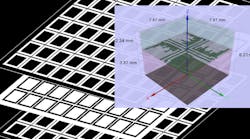Frequency-selective structures (FSSs) have come a long way since the early 1960s, due to advances in materials and manufacturing methods. These structures serve many different commercial and military applications, operating as antennas, filters, radomes, and other components in indoor and outdoor RF/microwave systems. They may be fabricated on materials as straightforward as dielectric substrates with laminated single-sided or double-sided copper sheets. Or they may use more elaborate construction materials such as multilayer printed-circuit boards (PCBs) with many different layers of conductive metals or inks providing circuit materials on the dielectric materials.
Depending on the frequency response desired for an FSS, passive circuit elements like capacitors or active devices (e.g., PIN or varactor diodes) may be added to the substrate material. Electrically conductive inks are often used in the construction of two-dimensional (2D) or three-dimensional (3D) FSSs, with some specialized conductive inks, such as silver nanoparticle inks, enabling the development of high-performance FSSs for a wide range of dielectric substrate materials. In some cases, the capabilities to deposit conductive ink droplets on demand on different substrate materials, including on paper and vinyl polymers, provides the flexibility to create form-fitting FSSs, even on glass surfaces.
As researchers at the Instituto de Telecomunicações in Leira, Portugal and the School of Telecommunication Engineering at the Universidade de Vigo in Spain have learned, work on solid- and liquid-based FSSs has been extensive, although they have attempted to simplify their review of FSSs, including the effects of substrate material parameters on circuit performance. Material parameters such as dielectric constant, dielectric loss, and even dielectric thickness were considered when comparing different FSS substrate materials and material technologies.
Specialized FSSs, such as fluid-based FSSs, may require structures apart from other forms of FSSs, like tubing for the electrically conductive fluid, but they may also provide the characteristics and performance levels that can not be achieved with other FSS types. Each FSS approach offers different costs, shape complexities, and tuning limits, and the reviewers encourage researchers exploring different FSS technologies to carefully consider the needs of their applications and how these technologies may serve their purposes.
See “A Review of Manufacturing Materials, and Production Methods for Frequency-Selective Structures,” IEEE Antennas & Propagation Magazine, Vol. 60, No. 6, December 2018, pp. 110-119.

